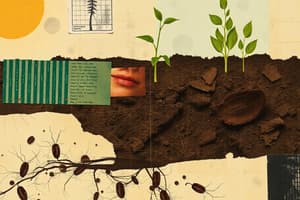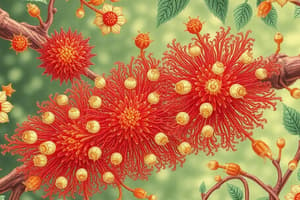Podcast
Questions and Answers
What method does Vampirococcus use to attack its prey?
What method does Vampirococcus use to attack its prey?
- It attaches to the outside of the cell and grows.
- It secretes enzymes to digest the prey.
- It consumes the entire cell.
- It pierces the cell and sucks out contents. (correct)
How does Myxococcus achieve its predation?
How does Myxococcus achieve its predation?
- By injecting toxins into the prey.
- By forming a micro-colony that surrounds its prey.
- By consuming the prey whole.
- By using a combination of gliding motility and enzymes. (correct)
What distinguishes Daptobacter from other microbial predators?
What distinguishes Daptobacter from other microbial predators?
- It attacks the prey without penetrating the cell.
- It relies on external substances for predation.
- It penetrates the prey and consumes cytoplasmic contents. (correct)
- It forms a symbiotic relationship with its host.
In microbial predation, what role does Bdellovibrio play?
In microbial predation, what role does Bdellovibrio play?
What characteristic is common among microbial predators such as Myxococcus and others discussed?
What characteristic is common among microbial predators such as Myxococcus and others discussed?
Which interaction is an example of amensalism?
Which interaction is an example of amensalism?
Which organism pair exhibits mutualism?
Which organism pair exhibits mutualism?
Which of the following describes a parasitic relationship?
Which of the following describes a parasitic relationship?
Which of the following is an example of a competitive interaction?
Which of the following is an example of a competitive interaction?
What type of interaction is keystone predation?
What type of interaction is keystone predation?
What type of relationship is characterized by some reciprocal benefit to both partners?
What type of relationship is characterized by some reciprocal benefit to both partners?
In a mutualistic relationship, what is a key characteristic regarding the interaction between the species?
In a mutualistic relationship, what is a key characteristic regarding the interaction between the species?
In the aphid-Buchnera aphidicola interaction, what does the microbe provide to the insect host?
In the aphid-Buchnera aphidicola interaction, what does the microbe provide to the insect host?
Which of the following mutualistic relationships involves a photosynthetic organism?
Which of the following mutualistic relationships involves a photosynthetic organism?
What percentage of organic matter for corals is produced by the Zooxanthellae?
What percentage of organic matter for corals is produced by the Zooxanthellae?
Which of the following describes the role of endosymbiotic microbes in mutualistic relationships?
Which of the following describes the role of endosymbiotic microbes in mutualistic relationships?
What do deep sea tube worms rely on for energy in their mutualistic relationships?
What do deep sea tube worms rely on for energy in their mutualistic relationships?
The holobiont system involving corals and Zooxanthellae can be described as which type of habitat?
The holobiont system involving corals and Zooxanthellae can be described as which type of habitat?
What initiates the infection process in the described context?
What initiates the infection process in the described context?
How does bacterial communication provide an advantage to bacteria?
How does bacterial communication provide an advantage to bacteria?
Which of the following statements best describes the characteristic of the bacterial communication mentioned?
Which of the following statements best describes the characteristic of the bacterial communication mentioned?
What role do furanones play in the described bacterial context?
What role do furanones play in the described bacterial context?
What is a consequence of the micro-colonies invading the host's epidermis?
What is a consequence of the micro-colonies invading the host's epidermis?
What might be a potential danger of bacterial communication through eavesdropping?
What might be a potential danger of bacterial communication through eavesdropping?
At what temperatures were the furanones tested for their effects on inoculation?
At what temperatures were the furanones tested for their effects on inoculation?
What is suggested by the phrase 'more “us” than “them”' in the context of bacterial communication?
What is suggested by the phrase 'more “us” than “them”' in the context of bacterial communication?
What is the relationship between leaf cutter ants and the fungus they cultivate?
What is the relationship between leaf cutter ants and the fungus they cultivate?
What is a critical function of the bacteria introduced by the ants to the fungal garden?
What is a critical function of the bacteria introduced by the ants to the fungal garden?
Which process converts ammonium ( ext{NH}_3) to nitrite ( ext{NO}_2)?
Which process converts ammonium ( ext{NH}_3) to nitrite ( ext{NO}_2)?
What describes commensalism?
What describes commensalism?
Which two bacteria are primarily responsible for the nitrification process?
Which two bacteria are primarily responsible for the nitrification process?
What is the role of the ants in maintaining their fungal garden?
What is the role of the ants in maintaining their fungal garden?
How do commensals benefit from host organisms?
How do commensals benefit from host organisms?
What is an example of a syntrophic interaction?
What is an example of a syntrophic interaction?
What distinguishes Streptomyces from other fungi?
What distinguishes Streptomyces from other fungi?
What do the leaf cutter ants primarily provide to the fungus?
What do the leaf cutter ants primarily provide to the fungus?
What is the primary purpose of AHL in quorum sensing?
What is the primary purpose of AHL in quorum sensing?
Which of the following describes autoinduction in quorum sensing?
Which of the following describes autoinduction in quorum sensing?
Which bacterium is associated with the production of the lux operon for bioluminescence?
Which bacterium is associated with the production of the lux operon for bioluminescence?
What role do response regulators like luxR play in quorum sensing?
What role do response regulators like luxR play in quorum sensing?
What phenotypes are associated with AHL signaling in bacteria?
What phenotypes are associated with AHL signaling in bacteria?
Which of the following signaling systems is NOT involved in AHL mediated quorum sensing?
Which of the following signaling systems is NOT involved in AHL mediated quorum sensing?
Why might bioluminescent bacteria benefit from emitting light?
Why might bioluminescent bacteria benefit from emitting light?
What type of molecules are primarily involved in AHL-mediated signaling systems?
What type of molecules are primarily involved in AHL-mediated signaling systems?
What mechanism allows bacteria to sense cell density in the environment?
What mechanism allows bacteria to sense cell density in the environment?
Which of the following statements about AHL diffusion is correct?
Which of the following statements about AHL diffusion is correct?
Flashcards
Mutualism Definition
Mutualism Definition
A relationship between two species where both benefit.
Mutualism Obligation
Mutualism Obligation
Mutualistic partners may need to live together, being dependent on each other.
Endosymbiotic Microbe Example
Endosymbiotic Microbe Example
A microbe living inside another organism providing essential nutrients (e.g., vitamins and amino acids).
Insect Host Example
Insect Host Example
Signup and view all the flashcards
Coral-Zooxanthellae Example
Coral-Zooxanthellae Example
Signup and view all the flashcards
Coral-Zooxanthellae function
Coral-Zooxanthellae function
Signup and view all the flashcards
Mutualistic relationship Example
Mutualistic relationship Example
Signup and view all the flashcards
Deep-sea tube worm mutualism
Deep-sea tube worm mutualism
Signup and view all the flashcards
Predation among Microbes
Predation among Microbes
Signup and view all the flashcards
Bdellovibrio Predation
Bdellovibrio Predation
Signup and view all the flashcards
Vampirococcus Predation
Vampirococcus Predation
Signup and view all the flashcards
Daptobacter Predation
Daptobacter Predation
Signup and view all the flashcards
Myxococcus Predation
Myxococcus Predation
Signup and view all the flashcards
Ant fungal garden
Ant fungal garden
Signup and view all the flashcards
Commensalism
Commensalism
Signup and view all the flashcards
Bacterial symbiont
Bacterial symbiont
Signup and view all the flashcards
Nitrification
Nitrification
Signup and view all the flashcards
Nitrosomonas
Nitrosomonas
Signup and view all the flashcards
Streptomyces
Streptomyces
Signup and view all the flashcards
Syntrophic interaction
Syntrophic interaction
Signup and view all the flashcards
Nitrobacter
Nitrobacter
Signup and view all the flashcards
Fungal antagonist
Fungal antagonist
Signup and view all the flashcards
Commensal relationship
Commensal relationship
Signup and view all the flashcards
Keystone Predation
Keystone Predation
Signup and view all the flashcards
Metabolic Symbiosis
Metabolic Symbiosis
Signup and view all the flashcards
Mutualism
Mutualism
Signup and view all the flashcards
Quorum Sensing
Quorum Sensing
Signup and view all the flashcards
AHL molecule
AHL molecule
Signup and view all the flashcards
Lux Operon
Lux Operon
Signup and view all the flashcards
LuxI
LuxI
Signup and view all the flashcards
Signal Diffusion
Signal Diffusion
Signup and view all the flashcards
AHL-Regulated Genes
AHL-Regulated Genes
Signup and view all the flashcards
Furanones in Bacterial Communication
Furanones in Bacterial Communication
Signup and view all the flashcards
Furanones: Advantage for Bacteria
Furanones: Advantage for Bacteria
Signup and view all the flashcards
Cross-Talk in Bacterial Communication
Cross-Talk in Bacterial Communication
Signup and view all the flashcards
Eavesdropping in Bacteria
Eavesdropping in Bacteria
Signup and view all the flashcards
Survival Strategy: Furanones
Survival Strategy: Furanones
Signup and view all the flashcards
Group Behavior: Furanones
Group Behavior: Furanones
Signup and view all the flashcards
Furanones: More 'Us' than 'Them'
Furanones: More 'Us' than 'Them'
Signup and view all the flashcards
Furanones: Impact on Host
Furanones: Impact on Host
Signup and view all the flashcards
Study Notes
Microbial Interactions
- Direct interactions have a direct impact of one organism on another without a third party. A (donor) has an effect on C (recipient)
- Direct impacts are more significant than indirect impacts in most ecosystems.
- Indirect impacts are impacts mediated by a third party (B) A (donor) affecting B (transmitter) that then effects C (recipient).
Types of Direct Interactions
-
Mutualism: Positive interaction for both organisms (+/+)
- Symbiotic relationship with obligation. Partners may need each other to live together
- Example: Aphid-Buchnera aphidicola interaction, deep sea tube worms, coral-zooxanthellae
-
Commensalism: Positive for one organism, neutral for the other (+/0)
- One organism benefits, the other is neither harmed nor helped.
- Often involves environmental modifications by one to benefit the other.
- Example: Microbial succession, surface microbes on plants or animals (organic compounds).
-
Predation: Positive for the predator, negative for the prey (+/-)
- Predator attacks and usually kills prey.
- Examples: Bdellovibrio, Vampirococcus, Daptobacter, Myxococcus
-
Herbivory: Positive for the herbivore, negative for the plant (+/-)
- Herbivore eats plant, plant is harmed
-
Parasitism: Positive for the parasite, negative for the host (+/-)
- Parasite benefits from living on the host and sometimes causes harm, while the host is harmed
- Example: Rickettsia typhi (causes Typhus)
-
Amensalism: Positive for one organism, negative for the other (+/-)
-
One organism benefits, but negatively impact another based on release of a specific compound
-
Examples: antibiotic production by fungi and bacteria, production of organic acids during fermentation
-
Competition: Negative for both organisms (-/-)
- Two organisms compete for the same resource
- One organism dominates, or both survive at lower populations
-
Co-operation: Positive for both organisms (+/+)
-
A form of symbiosis that involves syntrophic relationships; helps both species involved.
-
Example: Relationship between sulfide-oxidizing bacteria and various animals (e.g., sponges)
Other Important Interactions
- Nitrification: Conversion of ammonia to nitrite and then nitrate by bacteria (NH3 -> NO2 -> NO3)
- Fungal Farming by Ants: Ants cultivate fungus and feed them pieces of leaves, while ants consume the fungus.
- Keystone Species: Species with a disproportionate influence on their ecosystem. The influence on the community is often through trophic interactions. Example: Pisaster (starfish).
Indirect Interactions
-
Interaction chains - A donor species affects the abundance of a transmitter that effects a recipient (important in food webs)
-
Example: Bird predation -- caterpillars -- Herbivory in baby formula
-
Example: the creation of lactic acid by bifidobacterium, which inhibits the growth and lowering the disease incidence of pathogens in infants
-
Interaction modification - A donor species alters a transmitter's attribute (e.g., behavior) that therefore effects a recipient.
- Example: Bird predation influencing caterpillar abundance or behavior within their food webs
Studying That Suits You
Use AI to generate personalized quizzes and flashcards to suit your learning preferences.




